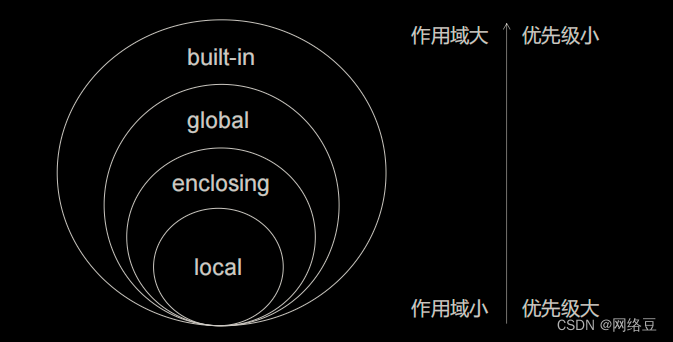
作者简介:一名在校计算机学生、每天分享Python的学习经验、和学习笔记。
座右铭:低头赶路,敬事如仪
个人主页:网络豆的主页
目录
前言
本章将会讲解Python编程中的 函数的作用域。
一.函数
1.函数作用域介绍
Python 中,程序的变量并不是在哪个位置都可以访问的,访问权限决定于这个变量是在哪里赋值
的。
变量的作用域决定了在哪一部分程序可以访问哪个特定的变量名称。Python 的作用域一共有4种,
分别是:
- L(local):局部作用域,即函数中定义的变量;
- E(enclosing):嵌套的父级函数的局部作用域,即包含此函数的上级函数的局部作用域,但不是 全局的;
- G(global):全局变量,就是模块级别定义的变量;
- B(build-in):内建作用域,系统固定模块里面的变量,比如:int()等;
"""
注意:if判断,for循环是没有作用域的概念。
"""
# if True:
# a =3
#
# print(a)
#
#
# for i in range(3):
# print("hello")
#
# print(i)2.L(local):局部作用域
# def test_one():
# #局部变量,该变量的作用域在函数体内部
# a = 5
# print(111,a)
#
#
# print(222,a)
# test_one()
#全局变量
a =100
def test_one():
print(f"a = {a}") #在局部没有时,则取全局变量中找,100
def test_two():
a = 200 #局部变量
print(f"a = {a}") #当局部有该变量时,则优先局部的。200
test_one()
test_two()3.G(global):全局变量
当我们需要在函数内部直接修改全局变量时,我们可以将函数内部的局部变量通过
global 关键字声 明为全局变
#global
#全局变量
a =10
def test_one():
print(f"a = {a}") #10
def test_two():
#a = 20 #初始化一个局部变量
#局部变量 ---->全局变量
global a
a = a+10
# a += 10
print(f"a = {a}") #当局部有该变量时,则优先局部的。200
test_one()
test_two()
4.函数作用域的优先级

# built-in 只要在Python环境中即可使用,了解即可
#int()
#global
a = 11
def outer():
b = 5 # enclosing
def inner():
nonlocal b
b = 6 #local
print(b)
inner()
print(b)
outer()创作不易,求关注,点赞,收藏,谢谢~